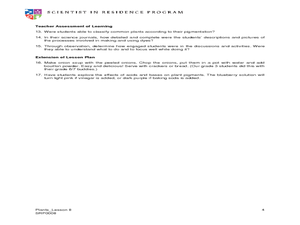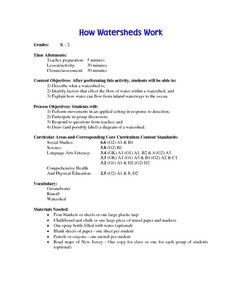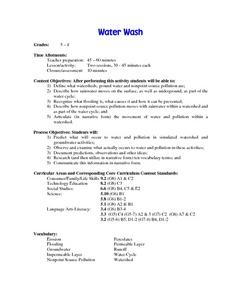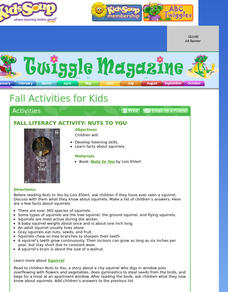Curated OER
Land Plants and Algae
Learners compare and contrast algae and land plants. In this plant lesson students discover what algae and land plants require for growth. The learners discuss experimental design. The students experiment with different treatments of...
Curated OER
Into the Bat Cave
Students explore the lives of bats. In this bat lesson plan, students participate in up 6 activities that focus on bats and build their background knowledge about the nocturnal mammals.
Curated OER
Botanical Garden Field Trip
Young scholars take a field trip to a botanical garden. For this habitat lesson, students walk through the garden and see various species of plants and animals. Young scholars take a canopy walk and see coniferous trees. Students write...
Curated OER
Food Chain: what's for dinner?
Fourth graders identify where foods came from and sequence a food chain. In this food chain lesson, 4th graders define vocabulary related to food chains and order a food chain. Students follow the energy of a food chain. Students...
Curated OER
Using Plant Pigments as Natural Dyes
Students create friendship bracelets and quilt squares. In this plant instructional activity student dye their own string and cotton material with plant pigments. Students use the naturally dyed materials to create the friendship...
Curated OER
Parts of the Flower and Pollination
Learners review the parts of the plant and recognize the parts that are important for pollination. In this pollination instructional activity, students illustrate and label the parts of a flower. Learners compare different types of...
Curated OER
First Nations Plants and their Uses
Students identify the uses of plants by researching Native Americans. In this First Nations culture lesson, students identify the First Nations coastal people of British Columbia and their use of plants such as seaweed, bark and moss....
Curated OER
How Wathersheds Work
Young scholars describe a watershed. They identify factors that effect the flow of water within a watershed. They explain how water can flow from inland waterways to the ocean.
Curated OER
Water Wash
Students define watersheds, ground water and nonpoint source pollution. They describe how rainwater moves on the surface, as well as underground, as part of the water cycle. They recognize what flooding is as well as its causes.
Curated OER
The Dose Makes The Poison
Students observe beakers of water that contain different amounts of a mystery chemical. They discuss how each amount of the chemical might affect them if the chemical was beneficial or harmful to their bodies.
Curated OER
Changes in Ecosystems
In this changes in ecosystems activity, students complete 21 various types of questions related to ecosystem. First, they determine whether each statement is true or false based on vocabulary. Then, students determine whether natural...
Curated OER
Primate Evolution
In this primate evolution worksheet, students use an idea map showing how primates have evolved into the different groups to complete 1 true or false and 2 short answer questions.
Curated OER
Exploring Forest Objects
Students explore the forest. In this ecosystems instructional activity, students rotate through sensory activity centers, brainstorm, and read about temperate forests.
Curated OER
Plant Vocabulary
In this plant worksheet, 3rd graders study vocabulary associated with plant life. Students use the given words to complete 9 fill in the blank statements.
Curated OER
Growing and Harvesting Fruits and Vegetables
Students learn the various parts of a farm and what is grown on a farm. They also match fruits and vegetables to locations where they are grown.
Curated OER
Herb is the Word
Students graph the data collected on seedling establishment and
survival for each soil type over a 6 week period. Each lab group graphs data
gathered from one plant. They choose a color for each soil type and create a key for the...
Curated OER
Amazing Bean Races
Students experiment with bean growth in varied conditions. In this plant biology lesson, students plant beans in soil and in spun cellulose (absorbent material in diapers) and measure the growth of their seedlings. They collect the data...
Curated OER
Next Year's Seeds
Sixth graders explore agricultural issues using math and probabilities. For this agriculture lesson, 6th graders investigate real world situations in agriculture using math and probabilities.
Channel Islands Film
Island Rotation: Lesson Plan 4
Foster's Rule? Allopatric speciation? After watching West of the West's documentary Island Rotation, class members use Venn diagrams to compare endemic species on the Channel Islands with mainland related species. They then create a...
Curated OER
Nuts About Squirrels
Early childhood students will develop listening skills as they read "Nuts To You" by Lois Ehlert. In this lesson students will learn about Students will learn facts about different types of squirrels and their behaviors. There will be a...
Curated OER
Know your roots!
Looking at an image of plant systems with their roots in the ground, learners determine which would be the most or least difficult to pull. They write short sentences describing which plant they chose and why. Intended for 3rd or 4th...
Curated OER
Garbage Plants
Students create plants out of garbage. They identify items that can be recycled and discuss natural resources. They share their creation with the class.
Curated OER
Simple Genetics Practice Problems
Geneticists of the future identify heterozygous and homozygous genotypes, describe phenotypes, and use Punnett squares to solve problems and determine characteristics of offspring. A total of 15 questions make this a compact quiz or...
Curated OER
Observing Root Response After Rotating Plant Ninety Degrees
Students conduct an experiment to observe the response of maize roots when rotated 90 degrees.

























